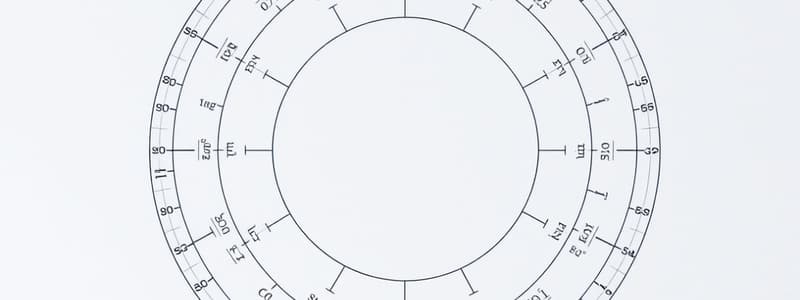Podcast
Questions and Answers
What is the first step taken to find the radius of curvature in the solution?
What is the first step taken to find the radius of curvature in the solution?
- Differentiate Y² with respect to θ. (correct)
- Apply the formula for the radius of curvature directly.
- Express dy/dθ in terms of a and θ.
- Set p² equal to y² plus the derivative of y.
What is the expression for P derived in the solution?
What is the expression for P derived in the solution?
- P = rac{y^{3}}{a^{2}} (correct)
- P = rac{y}{3a^{2}}
- P = rac{y^{6}}{a^{4}}
- P = rac{y^{2}}{a^{3}}
When simplifying the expression for 1/p², what form does it take?
When simplifying the expression for 1/p², what form does it take?
- 1/p² = rac{a^{4} ext{sin}^2 2θ + a^{4} ext{cos}^2 2θ}{y^{6}} (correct)
- 1/p² = rac{y^{4}}{a^{4}}
- 1/p² = rac{y^4 + a^{4} ext{sin}^2 2θ}{y^{6}}
- 1/p² = rac{a^{4}}{y^{4}}
What does dp/dy represent in the context of the solution?
What does dp/dy represent in the context of the solution?
What is the final simplified expression for P after differentiation with respect to y?
What is the final simplified expression for P after differentiation with respect to y?
Flashcards are hidden until you start studying
Study Notes
Curve Analysis
- The given curve equation is ( Y^2 = a^2 \sin 2\theta ).
- Radius of curvature, denoted as ( p ), is found using derivatives with respect to ( \theta ).
Derivatives and Formulas
- The first derivative related to ( \theta ):
- ( \frac{d^2y}{d\theta^2} = \frac{1}{y^2} + \frac{1}{y^4}\left(\frac{dy}{d\theta}\right)^2 ).
- The second derivative establishes the relationship between ( y ) and ( \theta ):
- ( 2y \frac{dy}{d\theta} = a^2 \cos 2\theta ).
- Leading to ( \frac{dr}{d\theta} = \frac{a^2 \cos 2\theta}{2} ).
Radius of Curvature Derivation
- The square of the inverse radius of curvature formula is manipulated as follows:
- ( \frac{1}{p^2} = \frac{1}{y^2} + \frac{a^4 \cos^2 2\theta}{4y^4} ).
- This is simplified and combined using trigonometric identities:
- ( \frac{1}{p^2} = \frac{y^4 + a^4 \cos^2 2\theta}{y^6} ).
- Further simplification gives ( \frac{1}{p^2} = \frac{a^4}{y^6} ).
Final Radius of Curvature Expression
- The radius of curvature ( p ) is ultimately expressed as:
- ( p = \frac{y^6}{a^4} ).
- It can also be represented as ( p = \frac{y^3}{a^2} ).
Additional Derivative Insights
- Relationship of ( p ) with respect to ( y ):
- ( \frac{dp}{dy} = \frac{3y^2}{a^2} ).
- Substitution in the radius of curvature leads to ( P = \frac{a^2}{3y} ).
Concluding Notes
- The calculations showcase the interrelation between the curve's geometry and its derivatives.
- Understanding the transformations and derivative applications is crucial for successfully deriving the radius of curvature in parametric forms.
Studying That Suits You
Use AI to generate personalized quizzes and flashcards to suit your learning preferences.




